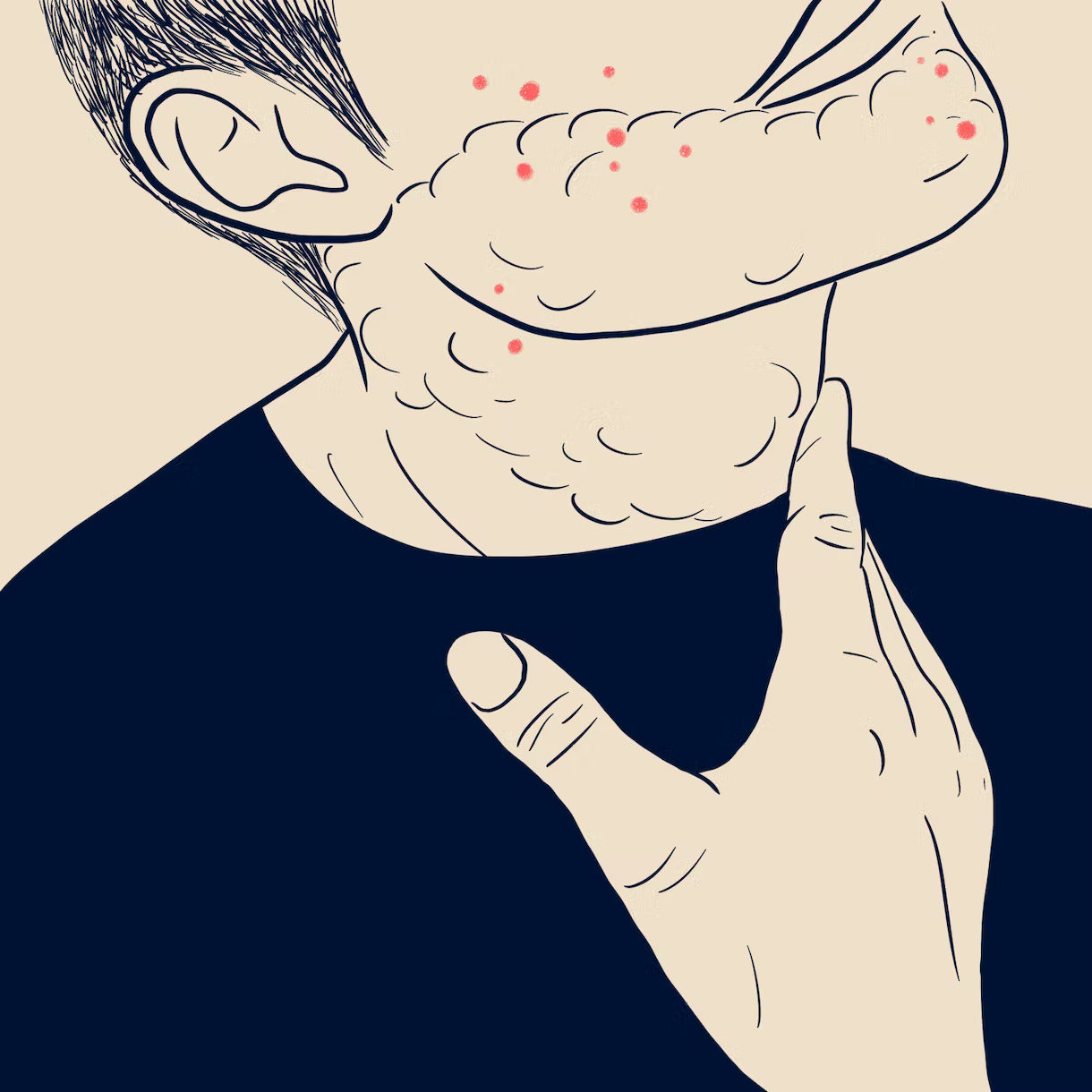
SHAVING WITH ACNE: BE BRAVE, SHAVE!
You’re not alone. A lot of folks are shaving with acne every day. 40-55% of people aged 20-40 suffer from breakouts. We’re here to help.
HERE'S A QUICK GUIDE:

HOW TO SHAVE WITH ACNE
Step 1: Cleanse
Cleanse with Oil Control Face Wash to rid your face of dirt and oil.
Step 2: Apply a shave aid
Work a dollop of translucent Shave Butter onto your cheeks for a smooth, close shave.
Step 3: Shave
Gently shave with our Club Series 4 blade razor. Rinse.
Step 4: Spot treatment
Apply Acne Eraser onto blemishes for visible results in two hours.
RECOMMENDED PRODUCTS
SHAVING WITH ACNE: FAQ'S
I'M HAVING A HARD TIME SHAVING WITH ACNE, WHAT'S THE BEST APPROACH?
First off, know that you’re not alone in struggling with this problem — studies indicate that 40-55% of people aged 20-40 suffer from breakouts, so a lot of folks are shaving with acne every day. It doesn’t have to be a hassle, though, if you use the correct products and the proper shaving technique.
SHAVING WITH ACNE, STEP 1: PREPARE YOUR FACE
The first step to shaving with acne is preparation: Dermatologist Shari Lipner recommends hopping into a hot shower to open up your pores and wash away dirt, grime and dead skin cells. You want to remove anything that might create friction — and therefore irritation — when you slide the razor across your face. It’s also worth considering using an exfoliating face wash, like our Prep Scrub, which helps remove dead skin so the razor can glide more smoothly. That said, it’s best to exfoliate lightly when dealing with acne-prone skin to avoid causing excess irritation.
SHAVING WITH ACNE, STEP 2: CHOOSE YOUR SHAVING PRODUCTS
The best shaving method for acne involves really lubing up that face, which provides extra protection and keeps the skin hydrated. Those worried about shaving with acne will likely want to choose a product that goes on translucent, like our Shave Butter, so you can easily see exactly what you’re shaving. (Shave Butter also softens the hairs for maximum glide, and is formulated to be gentle on your skin, just sayin’.)
SHAVING WITH ACNE, STEP 3: GET THE RIGHT RAZOR
Be sure to use a fresh razor — the less pressure you need to use the better, since more pressure equals more irritation. We recommend our 4 Blade razor for those with sensitive or acne-prone skin, since its four optimally-spaced blades rinse easily to help prevent the build up of hair, dirt and oil that can contribute to skin conditions like acne. Its lubricating strip will also help keep things smooth, and its slim profile makes it useful for tackling hard-to-shave spots.
SHAVING WITH ACNE, STEP 4: START SHAVING!
When figuring out how to shave with acne, Lipner advises that you, “Shave gently to avoid causing nicks when shaving over acne.” One of the simplest ways to stay safe is to shave with the grain — that is, shave in the direction your hair grows (as a general rule, shave with downward strokes on your face and upward strokes on your neck).
Once you’re done shaving, apply a soothing, oil-free moisturizer to calm and hydrate the skin. Job done!
DOES SHAVING YOUR FACE HELP WITH ACNE?
While shaving with acne the correct way can certainly help avoid making it worse, the act of shaving in and of itself isn’t going to help clear up your breakout. The good news is that shaving doesn’t cause acne, either.
If you’re suffering from red rashes after shaving, be aware that this is almost definitely not acne, but rather razor bumps, aka, ingrown hairs. These occur when the sharp tips of freshly shaved hairs curl around and grow back into the skin. The best way to avoid this is to exfoliate before shaving, and to always shave with the grain — when you shave against the grain, the hair is trimmed so short that it’s far easier for it to get embedded in the skin.
To deal with an existing razor rash, try a cold compress to soothe the skin, then apply a razor burn cream, like our Rescue Serum, which helps to calm post-shave redness and razor bumps.
WHY AM I GETTING ACNE AT MY AGE, ANYWAY?
Good question! If you’re a teenager, the most likely reason you’re experiencing acne is due to hormonal surges that cause your sebaceous glands to produce excess oil. This oil then clogs your pores, resulting in an outbreak of acne.
In terms of adult acne outbreaks, women tend to be more likely to suffer from these due to hormone fluctuations, but men can be afflicted too, most likely due to plain old sweat. When we sweat, the salty liquid acts like a pipe cleaner for our pores, pushing out any dirt and grime that’s lodged itself in our skin. That sweat and dirt mixture will settle back into your pores if you give it the chance, though.
This sweat issue is why you should take a shower or, at the very least, wash your face (which is where most of those troublesome sebaceous glands live) right after any particularly sweaty activity, or you could find yourself staring at a very spotty reflection before too long.
WHY DO I GET ACNE ON SUCH SPECIFIC PLACES ON MY BODY?
Ready for a quick biology lesson? It’s all about the location of your body’s oil-producing glands. Your body houses a number of pilosebaceous units, which are structures that contain both a sebaceous oil gland and a hair follicle. When these get inflamed, most likely due to bacterial growth, you end up with a pimple. The areas of your body with the highest numbers of these pilosebaceous units — your face, chest and upper back — are the places you’re most likely to get pimples.
BUT WHY DO THEY HAVE TO BE ON MY FACE??
Why we evolved with all our pilosebaceous units concentrated in these areas remains one of the body’s many mysteries. One theory is that, because these structures are responsible for sprouting hair and producing sebum (aka oil) — both of which are tools the body uses to protect and hydrate the skin — it only seems right that they’d be condensed in areas that are most susceptible to the sun, especially back before T-shirts or sunblock were a thing. Whatever the reason, the end result, annoyingly, is many of us dealing with the problem of shaving with acne. Stupid body!
HOW DO I KEEP MY PIMPLES UNDER CONTROL IN GENERAL?
Keeping your skin clean and hydrated is the number one way to help prevent outbreaks. Be sure to wash your face in the morning and again before you go to bed, ideally using an oil-control face wash. And of course, always follow the advice above when shaving with acne.
For sudden, unexpected pimple alerts, try tackling them with a dedicated acne cream. “Acne Eraser is a targeted solution for zits and blemishes that need a little more TLC,’” explains Dollar Shave Club’s Director of Product Development, Akanksha Tandon. “It can be either applied to specific trouble spots or to the whole affected area as a thin layer. The star ingredient is salicylic acid — which exfoliates and unplugs the clogged pores in your skin, helping to ‘erase’ pimples away — while the botanical extracts in the formula help soothe and calm skin. We performed clinical tests which showed the formula helps reduce the appearance of a zit in just two hours!”



